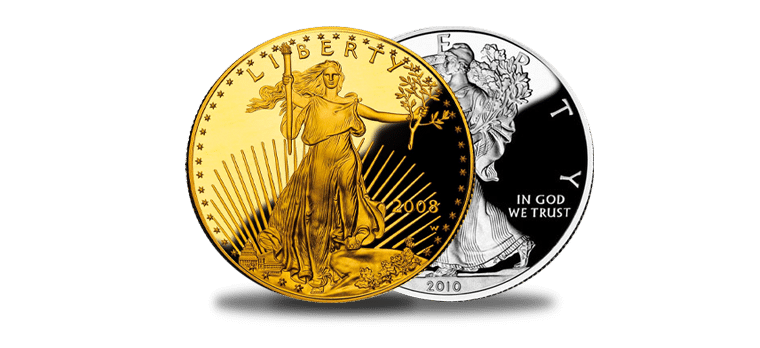Gold Vs Silver History

You’re about to dive into the riveting history of gold and silver. Exploring their impact on civilizations and economies, you’ll journey from ancient Egypt to today’s fluctuating markets.
You’ll see how industrial uses, supply and demand, and trading shape their value. Understanding this, plus the influence of commodity super cycles, will equip you to make savvy investment decisions.
To obtain a thorough understanding of the gold vs silver history, we should explore the following:
- Historical Overview of the Gold-Silver Ratio
- The Importance of the Gold-Silver Ratio for Investors
- The Early Days of Gold in the United States
- What are the limitations of using the gold-silver ratio?
- Gold & Silver as Currency
- Gold & Silver as an Investment
So, ready to delve into the gold and silver saga? Let’s get started.
Historical Overview of the Gold-Silver Ratio
Why should you care about the Gold-Silver Ratio (GSR) throughout history? The GSR provides you with a unique perspective on the precious metals market. It lets you understand how the relative value of gold and silver has changed over time. This knowledge could be crucial for your investment decisions.
Historically, the GSR fluctuated between 10 and 15. It even dropped as low as 2.5 in ancient Egypt, a time when silver was more scarce and therefore, prized. During the Roman Empire, the ratio was officially fixed at 12:1, demonstrating the government’s effort to control the monetary system.
Fast forward to 1792, the U.S Congress passed the first Coinage Act, fixing the GSR at 15. This mirrored the global market’s established ratio for gold and silver. However, market dynamics shifted, and the GSR drifted up to 15.5, prompting Congress to adjust the ratio to 16 in 1834. Simultaneously, gold’s price was set at $20.67.
Post-1873 marked the adoption of the gold standard, making gold the basis for the international monetary system. Consequently, the GSR began a gradual ascent. This uptrend was further exacerbated by the discovery of the Comstock Lode in Nevada, leading to a surge in U.S. silver output. This increased supply depressed silver’s price, causing the GSR to rise.
Understanding these historical fluctuations in the GSR can provide you with insights that may help you predict future trends, enabling you to make informed investment decisions. So, keep an eye on the GSR – it’s more than just a number
The Importance of the Gold-Silver Ratio for Investors
As an investor, understanding the gold-silver ratio’s significance can give you a strategic edge in the precious metals market. The gold-silver ratio is a powerful tool that can guide your investment decisions in precious metals, providing insights into the relative value of gold and silver.
- Hedging: One of the key advantages of using the gold-silver ratio is that it allows you to hedge your investments. If you anticipate a change in the ratio, you can simultaneously buy one metal while short-selling the other, protecting your investment from market fluctuations.
- Spotting Opportunities: The gold-silver ratio can help you identify investment opportunities. If the ratio reaches historically high or low levels, it could indicate that one metal is overvalued or undervalued, offering potential buying or selling opportunities.
- Risk Management:The gold-silver ratio can be a useful tool in managing risk. By trading the ratio, rather than the individual metals, you can profit regardless of whether gold and silver prices are generally rising or falling, as long as the ratio moves in the direction you anticipate.
- Historical Analysis: The gold-silver ratio has a rich history, and analyzing historical trends can provide valuable context for your investment decisions. Noting past fluctuations in the ratio can help you better understand potential future movements.
Working with a Trusted Gold and Silver Investment Company
When starting on the path of gold investing, working with a credible and trustworthy precious metals vendor is key. Finding an established gold investment company that understands the many vacillations of the gold markets and the numerous variables affecting its price will save much time and hassle. Working with a reputable company with institutional knowledge can assist you with logical price entry points, positioning, and dollar-cost-averaging so you can maximize your investment capital.
Gold IRAs provide additional advantages to merely buying gold from a local dealer. Choosing the right gold IRA company will depend on one’s unique investing needs. Depending on whether you are a high-net investor looking for the most competitive prices or require a lower investment minimum and affordable entry to the gold market, we have researched and reviewed our best 4 gold IRA and precious metal investment companies that meet those individual needs. In addition to a gold IRA, owning the physical gold in your residence is also an option. We have provided links to these companies at the bottom of this article for your convenience.
To learn more about how gold investing can protect your long-term wealth and the advantages of tax-deferred gold IRAs, click the banner below to access and download Augusta Precious Metals’ gold IRA checklist to make sure you are aware of all aspects of the gold IRA process:
The Early Days of Gold in the United States
While you’re considering the strategies and historical trends of the gold-silver ratio, it’s important to delve into the early days of gold in the United States, a period that significantly influenced the precious metals market. In 1783, when the Founding Fathers gained independence from England, gold and silver were already globally recognized currencies. It was only logical that these metals would form the backbone of the American monetary system, leading to the Coinage Act of 1792.
This Act, a direct response to the currency crisis caused by the Articles of Confederation, established the United States Mint and mandated the production of various denominations of coins in gold, silver and copper. It also certified the dollar as the country’s currency. However, the most notable aspect of the Act was the establishment of a gold-silver exchange rate.
The Act decreed that 15 pounds of pure silver was equivalent to 1 pound of gold under US law. Additionally, it set the value of each dollar at 24.75 grains of fine gold (around 0.057 ounces) or 371.25 grains of fine silver (approximately 0.85 ounces). This legislation marked a significant milestone in the nation’s financial history, as it was the first time an exchange rate for the new US dollar was put into writing.
Understanding this early period in America’s gold history can provide you with a broader perspective on the evolution of the precious metals market and the factors that have shaped it over time.
Best Gold IRA for Low Minimum Investment
What are the Limitations of Using the Gold-Silver Ratio?
You might be intrigued by the historical influence of the gold-silver ratio on the precious metals market, but it’s crucial to bear in mind that this tool does come with its own set of limitations. The ratio, while providing a useful insight into the relative value of these two metals, isn’t an all-encompassing guide for your investment decisions.
- Lack of Absolute Price Information:The gold-silver ratio doesn’t provide any information about the absolute price of gold or silver. It simply tells you how many ounces of silver it takes to purchase one ounce of gold. This lack of absolute price information can limit your understanding of the real value of these metals.
- Influence of External Factors:Economic factors such as crude oil prices, stock market performance, and Treasury yields can all impact the gold-silver ratio. The ratio isn’t immune to the effects of these external variables, which can lead to inaccurate interpretations of the market.
- Risk Factor:Like any other investment strategy, trading based on the gold-silver ratio involves risks. The ratio’s fluctuations are unpredictable and can result in losses if not interpreted correctly.
- Not a Standalone Tool:The gold-silver ratio shouldn’t be the only tool you use for making investment decisions. It’s important to consider other factors like market trends, geopolitical events, and other economic indicators to make a more informed decision.
Gold & Silver as Currency
Diving into the role of gold and silver as currency, it’s fascinating to see how these precious metals have shaped our financial system over the ages. From their early use in small villages that evolved into large towns, gold and silver became the preferred materials for minting coins. Their desirability and rarity made them ideal candidates for establishing a monetary value.
In ancient Greece, gold was standardized into coins, making transactions easier and more efficient. Similarly, the Lydians, now modern-day Turkey, introduced the first silver coins around 700BC. As the Romans expanded their empire, they revolutionized mining techniques, leading to an unprecedented production of gold and silver coins. These coins facilitated trade across their vast territories and were widely accepted, reinforcing the status of these metals as a universal currency.
The adoption of the gold standard by Great Britain in 1821 marked a significant turning point. The value of currency was pegged to gold, with coins and banknotes backed by real gold reserves. Although the gold standard was abandoned during the First World War due to economic pressures, it symbolizes the enduring value of gold and silver.
In the modern era, despite the prevalence of electronic transactions and digital currencies, gold and silver retain their allure. Their value extends beyond their use in jewelry and electronics, serving as a hedge against inflation and financial instability. As you navigate the complexities of the financial world, remember the enduring role of gold and silver as currency. Their historical significance continues to shape our financial system, underscoring their timeless appeal.
Gold & Silver as an Investment
Often, you’ll find that investing in gold and silver can be a reliable way to preserve wealth, especially during economic downturns. Unlike shares, gold and silver are tangible commodities always in demand, offering a reassuring safety net.
- Historical Value: Gold and silver have been consistently valuable throughout human history, from ancient markets to the modern economy. Even in the face of changing trading systems, they’ve remained sought after and valued.
- Economic Downturns: When the economy takes a hit, gold and silver often become even more desirable. Investors flock to these safe havens in times of uncertainty, causing the prices to surge. So, they can be a profitable investment when things look bad.
- Commodity Over Currency: Gold and silver, being real commodities, provide more security than investments based on a company’s share price, which could fail. When you invest in these metals, you’re buying something tangible, providing a sense of security.
- Longevity of Demand: The demand for gold and silver extends beyond their value as currency. They’re used in various industries, ensuring their demand remains high.
In essence, gold and silver have stood the test of time as reliable investments. Their longevity and consistent value, coupled with their performance during economic downturns, makes them an attractive investment option. While the modern economy may differ from the trading systems of the past, the fundamental principles that make gold and silver a sound investment remain unchanged. Remember, when you’re investing in these metals, you’re investing in a commodity that’s been valued across the breadth of human history.
Conclusion
So, you’ve journeyed through the riveting history of gold and silver. You’ve seen how they’ve shaped economies, influenced trading, and provided investment opportunities.
Now, understanding their past, their volatility, and the impact of supply and demand, you’re better equipped to make informed decisions. Remember, the gold-silver ratio isn’t a perfect tool, but it’s a useful guide.
Embrace the complexity of these precious metals and let history inform your future investments.
If you have 100k in savings to protect and want to take advantage of the best gold prices and lifetime customer support, attend a free gold and silver educational web conference hosted by Augusta Precious Metals. Secure your place today by clicking the banner below.
If you have 100k in savings to protect, attend a gold investment educational webinar hosted by Augusta Precious Metals. Tap the button below:
Obtain a gold IRA guide and talk to a broker




Gold IRA FAQs

Adam ONeill
Author, lifelong investor, and creator of PreciousMetalsInvestmentPortfolio.com



